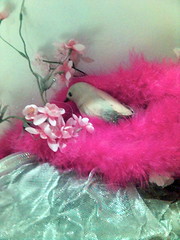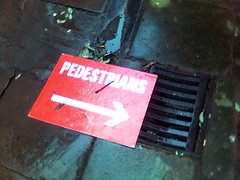TurboGears and the Python Imaging Library make writing applications that allow the reader to upload pictures a snap—which is a refreshing change.
Capturing Uploads the CherryPy Way
Most web-server frameworks make handling uploaded files difficult. Often this is because they were originally designed to make the more common case in mind: form items whose values are strings. When they add the ability to handle file uploads, it often looks like an afterthought. Microsoft’s ASP library required third-party extensions, I seem to recall; ASP .NET supplies for parameters as a statically typed, string-valued dictionary, so file uploads have to be done through an entirely separate interface—and so on.
TurboGears, through CherryPy, makes uploads easy. In fact it uses the same mechanism to pass uploaded files as any other form parameter:
@turbogears.expose(html="picky2.templates.addpicture")
def filepic(self, id, pic):
... process the arguments ...
return dict(...)
In order to work out why the pic parameter is different, you need have to look
at the template that contains the form for uploading pictures:
...
<h2>Add a picture</h2>
<form action="filepic?id=${panel.id}" method="post"
enctype="multipart/form-data" id="filepic">
...
<label for="pic">Picture file:</label> ...
<input type="file" name="pic" id="pic"/>
...
</form>
The essential differences are (1) the enctype attribute on the form element,
and (2) an input element with type="file" and, in this case, the name pic.
These changes mean that the argument pic passed to my method filepic is an
object rather than just a string. Its properties are sketchily documented as
part of Python’s cgi module and in section 3.1.6 of Chapter 3 of the CherryPy
book. It has three interesting member variables:
file: a file-like object from which we can read the data;filename: the name used for this file on the user’s computer; andtype: the MIME media-type of the file, as reported by the user’s computer.
The next two sections outline how I process the file in my toy application. None of this is particilary profound, so bored readers will probably want to skip it.
Storing the Picture Once it Has Arrived
Let’s step through the filepic method in order. In the Picky2 game, pictures
are uploaded as candidates for a panel. Our database model includes Panel and
Picture classes, and we pass the identifier of the current panel as one of the
parameters. The first thing we do is retrieve our person and panel info from the
database:
def filepic(self, id, pic):
pers = authentication.getLoggedInUser()
panel = model.Panel.get(id)
...
We could store the picture directly in the database. At work, we always end up doing that, because we a re terrified that one day we might need to migrate the application to a different server, and would have to remember to copy the files as well as the database itself, which apparently is an easy thing for database admins to forget. Nevertheless for Picky2, I intend to keep metadata in the database and store the picture data on disc. So I need to generate a file name for it.
You will recall that the upload object is supplied with a filename parameter,
and it would be nice if we could reuse that (if only during the debugging phase
of development). Of course, the file name supplied is in the form understood by
the user’s computer: it might be /Users/pdc/Pictures/bird.jpg or
C:\Documents and Settings\pdc.OCC\My Documents\My Pictures\bird.jpg. Also,
in the context of a jam-comics web game, players are likely to create files with
obvious names like panel.jpg, which will cause clashes—it would be tragic if
somone’s picture was clobbered because someone later on used the same name and
our server overwrote it.
We concoct a probably-unique file name for use on the web server from a combination of the following:
-
The date of upload (turned in to a directory name like
2006/03/07/); -
The identity of the uploader (munged into a directory name, so that
http://example.org/jsmithbecomesexample.org-jsmith); -
The last component of the file name from the user’s home computer (so the examples I gave above end up with
bird.jpg).
This gives something like 2006/03/07/example.org-jsmith/bird.jpg. The reason
for the directory structure is that eventually we might have hundreds or
thousands of pictures, and keeping them all in one directory might make looking
up files inefficient. (I am admittedly anticipating scaleability issues that are
unlikely to manifest given how obscure my game will be; and besides,
ReiserFS has BTree-based directories that do not degrade in performance when
they have enormous numbers of files.)
This scheme does expect a given person to avoid choosing the same name on the same day for different pictures. I ought to add something to cope with that case—either munging the name, or refusing the upload until they change the name. I’m not sure which.
We want to cap files saved on our system to a given maximum size (say 50K bytes). We do this by carefully only reading 1 byte more than the maximum size, and rejecting files that completely fill the buffer:
output = open(fileName, 'wb')
try:
size = 0
bytes = pic.file.read(1 + MAX_FILE_SIZE)
while bytes:
size += len(bytes)
if size > MAX_FILE_SIZE:
raise BadPictureException('Sorry, that file is too big: maximum size is %dK.'
% (MAX_FILE_SIZE // 1024))
output.write(bytes)
bytes = pic.file.read(1 + MAX_FILE_SIZE - size)
finally:
output.close()
This code assumes that pic.file.read may choose to not read all the bytes in the file in
one gulp—I have not checked whether this caution is actually required.
The important thing, though, is that if the file is too big, we throw an
exception BadPictureException. The above code is actually wrapped in a
try...except block, as follows:
try:
... read in the file as above ...
... process the file ...
return dict(...)
except BadPictureException, err:
# The uploaded picture was unsatisfactory; issue a message and try again.
os.unlink(fileName)
turbogears.flash(str(err))
raise cherrypy.HTTPRedirect('panel?id=%d' % id)
Anywhere in the file-processing where we need to reject the upload, we raise a
BadPictureException with an appropriate error message. The handler for the
exception cleans up the unwanted file and redirects back to the page with the
form on it. This is an example of a function that throws exceptions that it
catches itself (so that the clean-up code need only be written once).
Processing Images
We have now uploaded the picture and checked it is not too large for our disc. Another constraint on images is that they have a maximum size on the page. We can check this by using the Python Imaging Library:
im = Image.open(fileName)
width, height = im.size
if width > MAX_WIDTH:
raise BadPictureException('Sorry, that picture is too wide: maximum is %d pixels.'
% MAX_WIDTH)
if height > MAX_HEIGHT:
raise BadPictureException('Sorry, that picture is too tall: maximum is %d pixels.'
% MAX_HEIGHT)
If we wanted to generate thumbnails, this is where we would do it.
At this point we have saved the user’s upload, and verified that it is
acceptable. It is time to save a pointer to the newly created file in the
database. Having added some extra classes Picture and Vote to model.py,
the code to do this is quite short:
picture = model.Picture(uri=PICS_BASE_URI + picDir + name,
width=width, height=height, panel=panel, score=1, person=pers)
model.Vote(picture=picture, person=pers, value=1)
The second statement adds a vote from this user for their picture. Like Reddit, we assume that people only upload panels if they think they are good enough to be worth voting for. (They can unvote for their panel later if they really want to.) More on voting next episode.
Finally, like all CherryPy methods, we return a dictionary that is used by the template to create the HTML page:
return dict(picture=picture, panel=panel)
Ever Onwards
So it looks like I have got most of a Picky Picky Game clone together in a couple of afternoons’ sporadic work—it has a concept of panels (even if there is only one so far), and you can upload pictures to a panel and see them listed with your name underneath it. What remains is voting, spawining a new panel every week (or whatever), and arranging the most-voted pictures in to a strip. We’ll see how I get on with that next time I have a spare afternoon...

